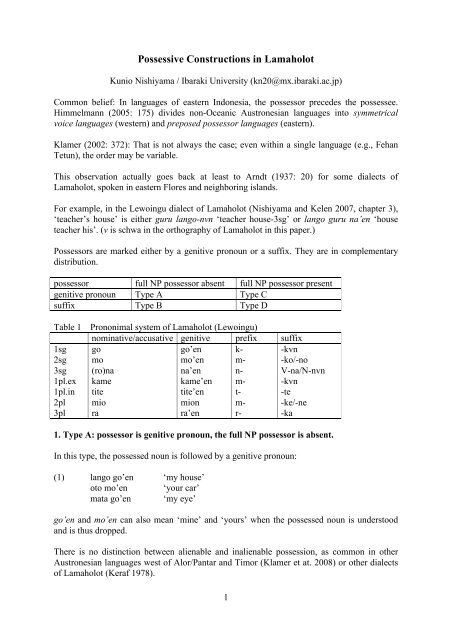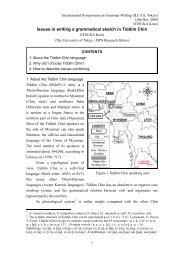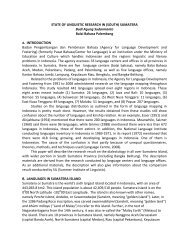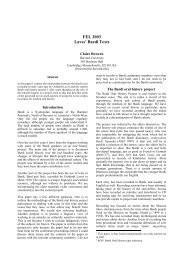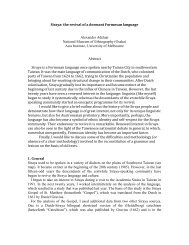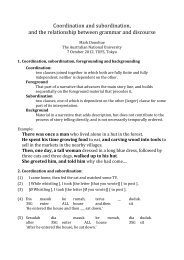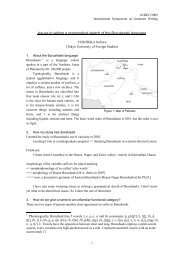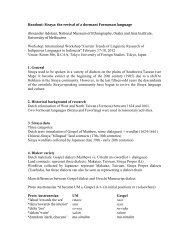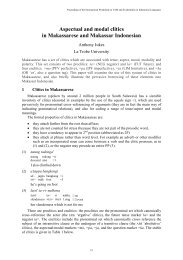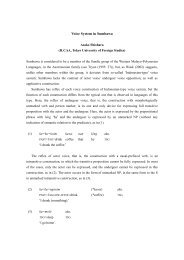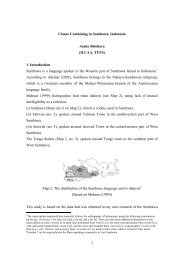Handout
Handout
Handout
Create successful ePaper yourself
Turn your PDF publications into a flip-book with our unique Google optimized e-Paper software.
Possessive Constructions in Lamaholot<br />
Kunio Nishiyama / Ibaraki University (kn20@mx.ibaraki.ac.jp)<br />
Common belief: In languages of eastern Indonesia, the possessor precedes the possessee.<br />
Himmelmann (2005: 175) divides non-Oceanic Austronesian languages into symmetrical<br />
voice languages (western) and preposed possessor languages (eastern).<br />
Klamer (2002: 372): That is not always the case; even within a single language (e.g., Fehan<br />
Tetun), the order may be variable.<br />
This observation actually goes back at least to Arndt (1937: 20) for some dialects of<br />
Lamaholot, spoken in eastern Flores and neighboring islands.<br />
For example, in the Lewoingu dialect of Lamaholot (Nishiyama and Kelen 2007, chapter 3),<br />
‘teacher’s house’ is either guru lango-nvn ‘teacher house-3sg’ or lango guru na’en ‘house<br />
teacher his’. (v is schwa in the orthography of Lamaholot in this paper.)<br />
Possessors are marked either by a genitive pronoun or a suffix. They are in complementary<br />
distribution.<br />
possessor full NP possessor absent full NP possessor present<br />
genitive pronoun Type A Type C<br />
suffix Type B Type D<br />
Table 1 Prononimal system of Lamaholot (Lewoingu)<br />
nominative/accusative genitive prefix suffix<br />
1sg go go’en k- -kvn<br />
2sg mo mo’en m- -ko/-no<br />
3sg (ro)na na’en n- V-na/N-nvn<br />
1pl.ex kame kame’en m- -kvn<br />
1pl.in tite tite’en t- -te<br />
2pl mio mion m- -ke/-ne<br />
3pl ra ra’en r- -ka<br />
1. Type A: possessor is genitive pronoun, the full NP possessor is absent.<br />
In this type, the possessed noun is followed by a genitive pronoun:<br />
(1) lango go’en ‘my house’<br />
oto mo’en ‘your car’<br />
mata go’en ‘my eye’<br />
go’en and mo’en can also mean ‘mine’ and ‘yours’ when the possessed noun is understood<br />
and is thus dropped.<br />
There is no distinction between alienable and inalienable possession, as common in other<br />
Austronesian languages west of Alor/Pantar and Timor (Klamer et at. 2008) or other dialects<br />
of Lamaholot (Keraf 1978).<br />
1
2. Type B: possessor is suffix, the full NP possessor is absent.<br />
In this type, a possessive suffix is attached to the possessed:<br />
(2) lango-ke ‘your (pl) house’<br />
bapa’-kvn ‘my father’<br />
bapa’-ko ‘your (sg) father’<br />
bapa’-nvn ‘his/her father’<br />
mata-kvn ‘my eye’<br />
mata-ko ‘your eye’<br />
For some speakers, the usage of nominal suffixes is restricted. Thus, genitive pronouns must<br />
be used instead for some nouns.<br />
Verbal suffix can attach to a noun to yield a verbal meaning. Since most suffixes are<br />
ambiguous between verbal suffix and nominal suffix, we can have non-possessive (verbal)<br />
constructions as follows:<br />
(3) lango-ke ‘Are you (pl) going to your house<br />
lango-ko ‘Are you (sg) going to your house<br />
The sentences can also mean ‘Did you go to your house,’ ‘You went to your house,’ or ‘This<br />
is your house.’ On the other hand, the genitive pronouns in Type A never induce a sentential<br />
meaning.<br />
Interesting cases are the third singular:<br />
(4) lango-nvn ‘his house’<br />
lango-na ‘He went to his house.’<br />
Only the third singular shows the division of labor between a nominal suffix and a verbal<br />
suffix: -nvn is a nominal suffix and -na is a verbal suffix.<br />
(5) buku-nvn ‘his book’<br />
buku-na ‘#He went to his book.’<br />
3. Type C: possessor is genitive pronoun, the full NP possessor is present.<br />
(6) lango guru na’en ‘the teacher’s house’<br />
house teacher his<br />
(7) *lango na’en guru<br />
lango guru<br />
When the possessed noun is understood, the noun can be dropped and guru na’en itself can<br />
mean ‘the teachers’ (something).’<br />
If the possessor is plural, ra’en is used:<br />
2
(8) lango guru ra’en ‘the teachers’ (pl) house(s)/faculty residence’<br />
house teacher their<br />
(9) labu inamvlake ra’en ‘(the) men’s shirt’<br />
shirt man their<br />
The possessor is either specific (‘the teachers’ (pl) house’ or ‘the men’s shirt’) or generic<br />
(‘faculty residence’ or ‘men’s shirt’). With either of the meaning, the genitive ra’en can be<br />
dropped. (This is due to the influence of Indonesian. Still, having ra’en is preferred to<br />
dropping it.)<br />
To make the specificity of the possessor clearer, the definite marker is used:<br />
(10) labu inamvlake pe’en na’en ‘the man’s shirt’<br />
shirt man the his<br />
Proper noun possession is as follows:<br />
(11) oto Lado na’en ‘Lado’s car’<br />
car L. his<br />
(12) lima Bala na’en ‘Bala’s hand’<br />
hand B. his<br />
Unlike in the case of the common noun possessor, the genitive is obligatory, and the order is<br />
fixed.<br />
4. Type D: possessor is suffix, the full NP possessor is present.<br />
(13) guru oto-nvn ‘teacher’s (sg) car’<br />
teacher car-3sg<br />
(14) guru oto-ka ‘teachers’ (pl) car’<br />
teacher car-3pl<br />
The verbal suffix -na is strictly prohibited in possessive construction: *guru oto-na ‘teacher<br />
car-3sg’ is ungrammatical. The same distinction as (13-14) can be made by the genitive<br />
pronoun in Type C possessive construction:<br />
(15) oto guru na’en ‘teacher’s (sg) car ‘<br />
(16) oto guru ra’en ‘teachers’ (pl) car’<br />
To express a generic possessor, the third plural -ka is used:<br />
(17) guru lango-ka ‘faculty residence’<br />
teacher house-3pl<br />
This also means ‘teachers’ (pl) house‘ with a specific possessor. Proper noun possessor is as<br />
follows:<br />
3
(18) Bala lango-nvn ‘Bala’s house’<br />
B. house-3sg<br />
Recall that the same meaning is expressed with Type C construction as lango Bala na’en<br />
‘house Bala his’, and the order is fixed for both constructions.<br />
(19) Bala oto-nvn ‘Bala’s car (sole owner)’<br />
B. car-3sg<br />
(20) Bala oto-ka ‘the Bala family’s car’<br />
B. car-3pl<br />
When the suffix is third singular, the possessor is the sole owner. When the suffix is plural,<br />
the possessor is the whole family.<br />
(21) Bala no’on Lepang lango-ka ‘Bala and Lepang’s house’<br />
B. and L. house-3pl<br />
(22) *Bala no’on Lepang lango-nvn<br />
B. and L. house-3sg<br />
When the possessor is plural, the suffix must also be plural.<br />
The choice between Type C and Type D seems to be a matter of focus. That is, of the two<br />
orders of possessor-possessed and possessed-possessor, whichever comes first gets focus.<br />
(23) go tvngv Bala lango-nvn hala’. go tvngv Lado lango-nvn.<br />
I see B. house-3sg not I see L. house-3sg<br />
‘I didn’t see Bala’s house. I saw Lado’s house.’<br />
(24) go tvngv Bala lango-nvn hala’. go niko tvngv oto (Bala) na’en<br />
I see B. house-3sg not I only see car B his<br />
‘I didn’t see Bala’s house. I only saw Bala’s car.’<br />
In the introducing part in both examples, the order is Bala lango-nvn. This might indicate that<br />
the possessor-possessed order (Type D) is an unmarked order.<br />
Double possessive is expressed as follows.<br />
(25) kvwae na’e loron bvsuk-nvn ‘his wife’s birthday’<br />
wife his day birth-her<br />
How did such a complicated system as described above emerge<br />
influence of Papuan languages (Klamer, Reesink, and van Staden 2008)<br />
4
The location of the languages discussed<br />
A: Alorese, B: Taba, F: Tetun Fehan, K: Kambera, L: Lamaholot, M: Maybrat, W: Teiwa<br />
5. Areal feature and Papuan influence<br />
Alorese (in Alor-Pantar) was earlier believed to be a dialect of Lamaholot, but Klamer (2011)<br />
shows that it is a language of its own. In contrast to Lamaholot, Alorese has no possessor<br />
suffixes (ibid: 52; see also Klamer forthcoming a: 10, forthcoming b: 10):<br />
(26) a. ni uma Alorese<br />
3sg house<br />
‘his house’<br />
b. bapa John ni uma Alorese<br />
father John 3sg house<br />
‘Bapa John’s house’<br />
The word order resembles that of Papuan languages (Klamer 2010: 189):<br />
(27) yivar ga-manak Teiwa<br />
dog 3sg-master<br />
‘the dog’s master’<br />
Thus, the Papuan influence seems stronger in Alorese, eradicating the original Austronesian<br />
possessed-possessor order. Lamaholot, in contrast, shows mixed features of Austronesian and<br />
Papuan, yielding complex characteristics.<br />
Another Papuan feature observed in Austronesian languages in eastern Indonesia is the<br />
position of negation. In both Lamaholot and Alorese, negation appears after the predicate:<br />
5
(28) a. go bvrin na hala' Lamaholot<br />
I hit him NEG<br />
‘I don't hit him.’ (Nishiyama and Kelen 2007: 69)<br />
b. no pana ha n-ei tahi lahe Alorese<br />
3sg walk this 3sg-go sea NEG<br />
‘He did not go to the sea [again].’ (Klamer forthcoming a: 6)<br />
This is also the case with most Austronesian languages in the Bird’s Head (Biak, Mor, Ambai,<br />
Waropen, Wandem-Windesi, Irarutu). For languages in the Moluccas, although many of them<br />
have preverbal negation, Taba and Buru have clause final negation (Klamer, Reesink, and van<br />
Staden 2008: 132f)<br />
(29) nik calana kuda-k asfal te Taba<br />
1sg.pos trousers be.black-appl bitumen NEG<br />
‘My trousers are not blackened with bitumen.’<br />
(Klamer, Reesink, and van Staden 2008: 133 < Bowden 2001: 336)<br />
Negation in Austronesian typically appears before predicates. This is true even with Kambera<br />
(in Sumba) and Tetun Fehan (in Timor), spoken in Lamaholot’s vicinity (Klamer, Reesink,<br />
and van Staden 2008: 132):<br />
(30) a. nda ku-hili beli-ma-nya-pa Kambera<br />
NEG 1sg.nom-again return-emph-3sg.dat-impf<br />
‘I am not going back to him again.’ (Klamer 1998: 77)<br />
b. hau la h-bá Tetun Fehan<br />
1sg NEG 1sg-go<br />
‘I’m not going.’ (van Klinken 1999: 229)<br />
Interestingly, Tetun Fehan also has a postverbal (but not sentence-final) negator:<br />
(31) hola ha’i na’an hola ha’i boek Tetun Fehan<br />
take NEG meat take NEG shrimp<br />
‘They didn’t catch fish, they didn’t catch shrimp.” (van Klinken 1999: 229)<br />
In contrast, negations in Papuan languages constantly appear after predicates. This is true<br />
regardless of whether the language is SVO or SOV<br />
(32) ana m-amo Kumurkek fe Maybrat<br />
they 3pl-go K.<br />
NEG<br />
‘They do not go to Kumurkek.’<br />
(Klamer, Reesink, and van Staden 2008: 130 < Dol 1999: 127)<br />
(33) na ha’an pua-n yaa qai maan Teiwa<br />
1s you snap-real descend just NEG<br />
‘I’m not cheating you.’ (Klamer 2010: 275)<br />
Thus, post-predicative negation is a Papuan feature spreading over part of Austronesian<br />
languages in eastern Indonesia.<br />
6
References<br />
Arndt, P. Paul. 1931. Grammatik der Sika-sprache. Ende, Flores: Arnoldus-Drukkerij.<br />
Bowden, John. 2001. Taba. Pacific Linguistics, Australian National University.<br />
Dol, P. 1999. A grammar of Maybrat. Ph.D. dissertation, Leiden University.<br />
Himmelmann, Nikolaus P. 2005. The Austronesian languages of Asia and Madagascar:<br />
Typological characteristics. In The Austronesian languages of Asia and Madagascar,<br />
ed. K Alexander Adelaar and Nikolaus Himmelmann, 110-181. London:<br />
Routledge/Curzon.<br />
Keraf, Gregorius. 1978. Morfologi dialek Lamalera, Ende, Flores: Percetakan Offset<br />
Arnoldus.<br />
Klamer, Marian. 1998. A grammar of Kambera. Berlin: Mouton.<br />
Klamer, Marian. 2002. Typical features of Austronesian languages in central/eastern<br />
Indonesia. Oceanic Linguistics 41: 363-383.<br />
Klamer, Marian. 2010 A grammar of Teiwa. Berlin: Mouton.<br />
Klamer, Marian. 2011 A short grammar of Alorese (Austronesian). Munich: Lincom.<br />
Klamer, Marian. Forthcoming a. Papuan-Austronesian language contact: Alorese from an<br />
areal perspective. To appear in Language Documentation and Conservation.<br />
Klamer, Marian. Forthcoming b. From Lamaholot to Alorese: Simplification without shift. In<br />
David Gil, John McWhorter and Scott Paauw (eds.), Austronesian undressed: How<br />
and why languages become isolating.<br />
Klamer, Marian, Reesink, Ger and Staden, Miriam van. 2008. East Nusantara as a linguistic<br />
area. From linguistic areas to areal linguistics, Pieter Muysken ed., 95-149.<br />
Amsterdam: Benjamins.<br />
Nishiyama, Kunio and Herman Kelen. 2007. A grammar of Lamaholot, eastern Indonesia:<br />
the morphology and syntax of the Lewoingu dialect. Munich: Lincom.<br />
van Klinken, Catharina Lumien. 1999. A grammar of the Fehan dialect of Tetun. Pacific<br />
Linguistics, Australian National University.<br />
7


